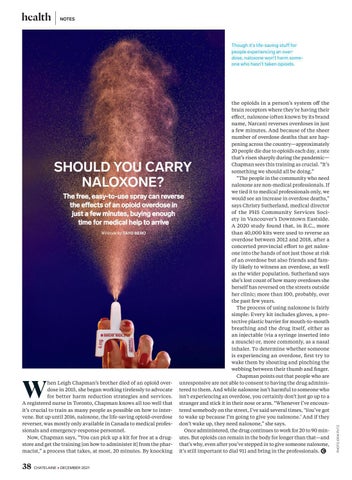health
NOTES
Though it’s life-saving stuff for people experiencing an overdose, naloxone won’t harm someone who hasn’t taken opioids.
the opioids in a person’s system off the brain receptors where they’re having their effect, naloxone (often known by its brand name, Narcan) reverses overdoses in just a few minutes. And because of the sheer number of overdose deaths that are happening across the country—approximately 20 people die due to opioids each day, a rate that’s risen sharply during the pandemic— Chapman sees this training as crucial. “It’s something we should all be doing.” “The people in the community who need naloxone are non-medical professionals. If we tied it to medical professionals only, we The free, easy-to-use spray can reverse would see an increase in overdose deaths,” the effects of an opioid overdose in says Christy Sutherland, medical director of the PHS Community Services Socijust a few minutes, buying enough ety in Vancouver’s Downtown Eastside. time for medical help to arrive A 2020 study found that, in B.C., more Written by TAYO BERO than 40,000 kits were used to reverse an overdose between 2012 and 2018, after a concerted provincial effort to get naloxone into the hands of not just those at risk of an overdose but also friends and family likely to witness an overdose, as well as the wider population. Sutherland says she’s lost count of how many overdoses she herself has reversed on the streets outside her clinic; more than 100, probably, over the past few years. The process of using naloxone is fairly simple: Every kit includes gloves, a protective plastic barrier for mouth-to-mouth breathing and the drug itself, either as an injectable (via a syringe inserted into a muscle) or, more commonly, as a nasal inhaler. To determine whether someone is experiencing an overdose, first try to wake them by shouting and pinching the webbing between their thumb and finger. Chapman points out that people who are hen Leigh Chapman’s brother died of an opioid over- unresponsive are not able to consent to having the drug adminisdose in 2015, she began working tirelessly to advocate tered to them. And while naloxone isn’t harmful to someone who for better harm reduction strategies and services. isn’t experiencing an overdose, you certainly don’t just go up to a A registered nurse in Toronto, Chapman knows all too well that stranger and stick it in their nose or arm. “Whenever I’ve encounit’s crucial to train as many people as possible on how to inter- tered somebody on the street, I’ve said several times, ‘You’ve got vene. But up until 2016, naloxone, the life-saving opioid-overdose to wake up because I’m going to give you naloxone.’ And if they reverser, was mostly only available in Canada to medical profes- don’t wake up, they need naloxone,” she says. sionals and emergency-response personnel. Once administered, the drug continues to work for 20 to 90 minNow, Chapman says, “You can pick up a kit for free at a drug- utes. But opioids can remain in the body for longer than that—and store and get the training [on how to administer it] from the phar- that’s why, even after you’ve stepped in to give someone naloxone, macist,” a process that takes, at most, 20 minutes. By knocking it’s still important to dial 911 and bring in the professionals.
SHOULD YOU CARRY NALOXONE?
38
CHATELAINE • DECEMBER 2021
PHOTO, ERIK PUTZ.
W














